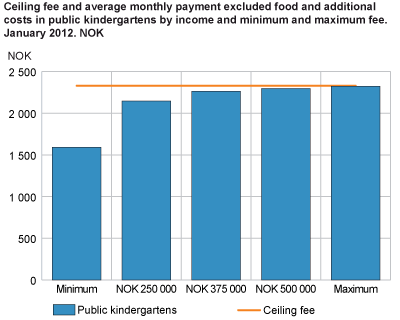Content
Published:
This is an archived release.
Kindergarten fees slightly higher
For a household with an annual income of NOK 500 000, the average monthly fee at national level for one child in public kindergarten was NOK 2 297 in January 2012. This is up 0.9 per cent from January 2011.
The household payments survey in January 2012 indicates that the monthly fees remained steady compared to January 2011. However, the food costs increased in the same period.
Small changes in kindergarten payment schemes
The average monthly fee at national level in public kindergartens was NOK 2 145 for a household with an income of NOK 250 000, NOK 2 262 for those with NOK 375 000 and NOK 2 297 for households with an income of NOK 500 000. Food and additional costs are, where possible, excluded from these figures.
In January 2012, the average minimum monthly fee for a place in a municipal kindergarten excluding food and additional costs was NOK 1 592, while the average maximum monthly fee was NOK 2 324. The kindergarten payment scheme is mostly unchanged. This means that there are still considerable regional differences; the majority of the municipalities with low minimum monthly fees are in the south and east of Norway, while most of the municipalities with high minimum monthly fees are in the central and northern parts of Norway. The large variations in the minimum fees are the result of an income-differentiated payment system that is more commonly used in the south and east rather than in central and northern Norway, where flat rates are used to a greater extent. Ninety-two per cent of public kindergartens state that the maximum monthly fee is maintained at the maximum rate of NOK 2 330.
As of January 2012, the monthly kindergarten fee excluding food and additional costs for families with one child in a private kindergarten averaged NOK 2 295. A total of 91 per cent of private kindergartens state that the maximum monthly fee is maintained at the government imposed maximum fee of NOK 2 330.
Weak increase in food costs
In accordance with the regulations on household payments in kindergartens, payments for food costs can be charged in addition to the regular fees. The annual fee for one child attending kindergarten is determined by the monthly fee, food and additional costs, in addition to the number of months of payment.
About 95 per cent of public kindergartens charge food fees separately. In public kindergartens, the food costs for a household with one child attending public kindergarten averaged NOK 209 in January 2012; a 3 per cent increase from January 2011.
Eighty-five per cent of the private kindergartens charge food fees in addition to the regular fees.
Price reduction systems more common in densely populated municipalities
Regulations on household payments in kindergartens state that all municipalities must offer reduced payments or payment exemption to families with low incomes. However, the municipalities are free to decide whether to offer income-differentiated payments or not in public kindergartens.
A total of 22 per cent of the municipalities offer income-differentiated payments within their ordinary payment system. However, it is the most densely populated municipalities that make the most use of income-differentiated payments. Due to this, just under half of all children who attend public kindergartens belong to a municipality that offers a price reduction system. Twenty-eight per cent of private kindergartens report that they offer income-differentiated payment.
Results also show that all municipalities offer price reductions for households with two or more children in kindergarten. In addition, 88 per cent of the municipalities that have reported the existence of private kindergartens in the municipality, report that these operate with the same price reduction system as the public kindergartens.
Contact
-
Hamdi A. Mohamed
E-mail: hamdi.mohamed@ssb.no
tel.: (+47) 46 81 54 76
-
Gunnar Larsson
E-mail: gunnar.larsson@ssb.no
tel.: (+47) 40 90 26 79
-
Silje Skjolden Thorsnes
E-mail: silje.skjolden.thorsnes@ssb.no
tel.: (+47) 45 66 42 04

